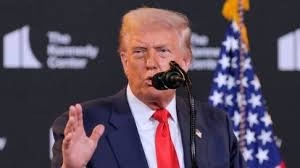US President Donald Trump on Thursday announced a major reduction in tariffs on Chinese goods — from 57% to 47% — following what he called an “amazing” meeting with Chinese President Xi Jinping in South Korea. The talks, which covered trade, technology, rare earths, and the fentanyl crisis, marked the most significant thaw in Washington-Beijing relations since Trump’s return to office.
Trump said China would “immediately” begin large-scale purchases of American soybeans and that both nations had reached an extendable one-year agreement on rare earth supplies. “All the rare earth issue has been settled,” Trump said aboard Air Force One, adding that the deal would be reviewed annually. He also announced a cut in fentanyl-related tariffs on China to 10%.
The meeting reportedly removed several “roadblocks” between the two economic powers. Trump said both sides would “work together to get something done” on Ukraine and that Beijing would soon engage with US semiconductor firms such as Nvidia, though “not about Blackwell chips.” He added that Taiwan was not discussed during the talks. Trump is scheduled to visit China in April, with Xi expected to make a reciprocal trip to the US later in the year.
China Confirms ‘Consensus’ on Trade Cooperation
Following the talks, Chinese President Xi Jinping said the two sides should “look at the long-term interest of cooperation” and avoid a “vicious cycle of revenge.” He emphasized that China “never wanted to challenge or replace anyone,” adding that both nations’ economic teams had “reached consensus on solutions to problems.”
State media outlet Xinhua reported that Trump and Xi agreed to strengthen cooperation in energy and trade, while expanding joint efforts to tackle telecom fraud and money laundering. Xi said both sides should “shorten the list of problems and lengthen the list of cooperation.”
From Tariff War to Tentative Truce
The development comes after nearly a year of escalating trade tensions. In February 2025, Trump imposed a 10% tariff on all Chinese imports, citing a “national emergency” linked to fentanyl trafficking. Beijing retaliated with duties on American energy and agricultural goods and investigations targeting US companies.
By April, tariff rates on both sides had surged above 100%, and China imposed export restrictions on rare earth materials critical for semiconductors and electric vehicles. Temporary truces reached during meetings in Geneva, London, and Stockholm failed to produce lasting relief, while tensions flared again in October when Trump threatened new 100% tariffs unless China eased its rare-earth curbs.
Fentanyl Controls as Key to Tariff Cuts
Ahead of the latest meeting, reports suggested that Trump and Xi were negotiating a framework that would see the US reduce tariffs in exchange for China’s commitment to curb exports of precursor chemicals used in fentanyl production. The final details are expected to be settled in follow-up discussions.
The Thursday meeting was part of Trump’s broader Asia tour, which included stops in Cambodia and Thailand. In the run-up to the talks, both sides signaled optimism — with China’s top trade negotiator Li Chenggang confirming a “preliminary consensus,” and US Treasury Secretary Scott Bessent calling the framework “very successful.”
The agreement now paves the way for renewed trade between the world’s two largest economies, with both governments expressing cautious optimism that the détente could restore stability to global markets.

